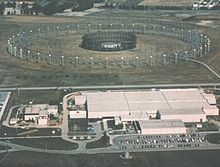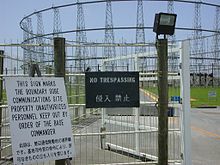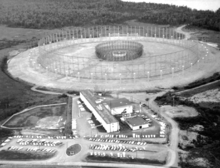- Wullenweber
-
The Wullenweber (the original name introduced by Dr. Hans Rindfleisch was Wullenwever) is a type of Circularly Disposed Antenna Array (CDAA) sometimes referred to as a Circularly Disposed Dipole Array (CDDA). It is a large circular antenna array used for radio direction finding. It was used by the military to triangulate radio signals for radio navigation, intelligence gathering and search and rescue. Because its huge circular reflecting screen looks like a circular fence, the antenna has been colloquially referred to as the elephant cage. The term wullenwever was the World War II German cover term used to identify their secret CDAA research and development program; its name is unrelated to any person involved in the program.
History
Wullenweber technology was developed by the German navy communication research command, Nachrichtenmittelversuchskommando (NVK) and Telefunken during the early years of World War II. The inventor was NVK group leader Dr. Hans Rindfleisch, who worked after the war as a Technical Director for the northern Germany official broadcast ( Norddeutscher Rundfunk - NDR). Technical team leaders were Dr. Joachim Pietzner, Dr. Hans Schellhoss, and Dr. Maximilian Wächtler. The latter was a founder of Plath GmbH in 1954 and later a consultant to both Plath and Telefunken.
Dr. Rolf Wundt, a German antenna researcher, was one of hundreds of German scientists taken to the U.S. by the Army after the war under Operation Paperclip. He arrived in New York in March, 1947 on the same ship as Wernher Von Braun and his wife and parents. He was first employed by the U.S. Air Force, then by GT&E Sylvania Electronics Systems on Wullenweber and other antenna projects.
Although the three men retired in West Germany, some of their second-echelon technicians were taken to the USSR after the war. At least 30 Krug (Russian for circle) arrays were installed all over the Soviet Union and allied countries in the 1950s, well before the U.S. military became interested and developed their own CDAAs. Several Krugs were installed in pairs within less than 10 km kilometers of each other, apparently for radio navigation purposes. At least four Krugs were installed near Moscow; just to the north, east and south (55°27′51″N 37°22′11″E / 55.46408°N 37.3698°E) of the city. The Krugs were used to track the early Sputnik satellites, using their 10 and 20 MHz beacons, and were instrumental in locating re-entry vehicle.
The first Wullenwever was built during the war at Skisby (in German: Hjörring), Denmark (57°28′39″N 10°20′04″E / 57.4775°N 10.33444°E). It used forty vertical radiator elements, placed on the arc of a circle with a diameter of 120 meters. Forty reflecting elements were installed behind the radiator elements, suspended on a circular wooden support structure with a diameter of 112.5 meters. To more easily obtain true geographic bearings, the north and south elements were placed exactly on the North-South meridian. The Soviet Krug arrays also use the 40 radiator Wullenwever configuration.
The array in Skisby was extensively studied by the British, then destroyed following the war in accordance with the Geneva Convention. Dr. Wächtler arranged to have a second array built, at Telefunken expense, at Langenargen/Bodensee, for further experimentation after the war. In the years following the war, the U.S. disassembled the Langenargen/Bodensee array and brought it back to the U.S., where it became known as the "Wullenweber" array.
Professor Edgar Hayden, then a young engineer in the University of Illinois Radio Direction Finding Research Group, led the reassembly of the Wullenweber, studied the design and performance of HF/DF arrays and researched the physics of HF/DF under contract to the U.S. Navy from 1947 through 1960. His research is still used today to guide the design and site selection of HF/DF arrays. Records of his research are available in the university's archives. Hayden was later employed by Southwest Research Institute where he continued to contribute to HF direction finding technology.
Hayden led the design and development of a large Wullenweber array at the university's Bondville Road Field Station, a few miles southwest of Bondville, IL. The array consisted of a ring 120 vertical monopoles covering 2-20 MHz. Tall wood poles supported a 1,000-foot-diameter (300 m) circular screen of vertical wires located within the ring of monopoles. Due to their immense size, the location of the Bondville array (40°02′58″N 88°22′51″W / 40.0494°N 88.3807°W) and the other post-war Wullenweber arrays are clearly visible in high resolution aerial photography available on the internet.
In 1959, the U.S. Navy contracted with ITT Federal Systems to deploy a worldwide network of AN/FRD-10 HF/DF arrays based on lessons learned from the Bondville experimental array. The FRD-10 at NSGA Hanza, Okinawa was the first installed, in 1962, followed by eleven additional arrays, with the last completed in 1964 at NSGA Imperial Beach, CA. (Silver Strand) A pair of FRD-10s not equipped for HF/DF were installed in 1969 at NAVRADSTA(R) Sugar Grove, WV for naval HF communications, replacing the NSS receiver site at the Naval Communications Station in Cheltenham, MD. The last two FRD-10 HF/DF arrays were installed in 1971 for the Canadian Forces in Gander, Newfoundland and Masset, British Columbia. After the Hanza array was decommissioned in 2006, the Canadians now operate the last two FRD-10 arrays in existence.
Also in 1959, a contract to build a larger Wullenweber array—the AN/FLR-9 antenna receiving system—was awarded by the U.S. Air Force to GT&E Sylvania Electronics Systems (now General Dynamics Advanced Information Systems). The first FLR-9 was installed at RAF Chicksands (52°02′39″N 0°23′21″W / 52.0443°N 0.389182°W), United Kingdom in 1962. The second FLR-9 was installed at San Vito dei Normanni Air Station, Italy also in 1962. The Chicksands array was dismantled following base closure in 1996 and the San Vito array was dismantled following base closure in 1993.
A second contract was awarded to Sylvania to install AN/FLR-9 systems at Misawa AB, Japan; Clark AB, Philippine Islands; Pakistan (never built); Elmendorf AFB, Alaska; and Karamursel AS, Turkey. The last two were completed in 1966. The Karamursel AS was closed and array was dismantled in 1977 in retribution for the suspension of U.S. military aid to Turkey. The Clark AB array was decommissioned after the Mt. Pinatubo volcano eruption in 1991. It was later converted into an outdoor amphitheater. As of 2007, only the Elmendorf and Misawa arrays remain in service, but both are likely to be decommissioned soon due to their age and unavailability of repair parts.
The U.S. Army awarded a contract in 1968 to F&M Systems to build AN/FLR-9 systems for USASA Field Station Augsburg, Germany and Camp Ramasun in Udon Thani Province, Thailand. Both were installed in 1970. The Army version has the same design as the Air Force version, but the design of the delay lines in the Beam Forming Networks inside the Central Building are different. The Army used what is called a "Lamp Cluster" delay line design and the Air Force used a "Coaxial" delay line design. The Camp Ramasun array was dismantled in 1975 following base closure. The Augsburg array was turned over to the Bundesnachrichtendienst -- the German Intelligence Service known as the BND—in 1998, and it is no longer believed to be in service.
During the 1970s, the Japanese government installed two large Wullenweber arrays, similar to the FRD-10, at Chitose and Miho.
Later in the 1970s, Plessey -- now Roke Manor Research Limited -- of Great Britain developed their smaller, more economical Pusher CDAA array. At least 25 Pusher CDAAs were installed in many countries around the world. Several Pusher arrays were installed in U.S. military facilities, where the array is known as the AN/FRD-13.
Today, the Strategic Reconnaissance Command of the German Armed Forces operates a wullenweber array in Bramstedtlund with a diameter of 410m as one of its three stationary Sigint battalions.
See also
- HF/DF
- Radio direction finder
- Radio direction finding
- Direction finding
- AN/FLR-9, a Wullenweber-class antenna array
- SIGINT
- Silver Strand Training Complex
External links
- Description and Photographs of the first Wullenwever array in Skisby, Denmark
- Aspects of the German Naval Communications Research Establishment
- Wullenweber/CDDA Antenna Homepage
- Aerial photographs of Krug arrays
- Aerials photographs of FRD-10 arrays
- Aerial photographs of AN/FLR-9 arrays
- Satellite view of Misawa AFB, Japan antenna
Antenna types Isotropic Omnidirectional Coaxial antenna · Dipole antenna · Discone antenna · Folded unipole antenna · Ground-plane antenna · Helical antenna · J-pole antenna · Mast radiator · Monopole antenna · Random wire antenna · Rubber Ducky antenna · T2FD Antenna · Whip antennaDirectional AWX antenna · Beverage antenna · Cantenna · Collinear antenna · Fractal antenna · Ground dipole · Helical antenna · Horizontal curtain · Horn · Inverted vee antenna · Log-periodic antenna · Loop antenna · Microstrip antenna · Patch antenna · Phased array · Parabolic antenna · Plasma antenna · Quad antenna · Reflective array antenna · Regenerative loop antenna · Rhombic antenna · Sector antenna · Short backfire antenna · Slot antenna · Turnstile antenna · Vivaldi-antenna · Yagi-Uda antennaApplication-specific Categories:- Radio frequency antenna types
Wikimedia Foundation. 2010.



